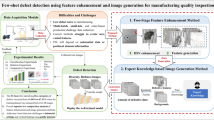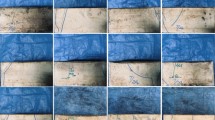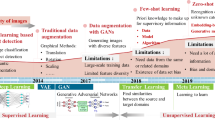Abstract
Defect detection in various industrial products ensures product quality and safety. This paper introduces an innovative design, training, and evaluation application employing CNN, CAE, YOLO, FCN, and SVM models, to facilitate defect detection without requiring extensive IT expertise. However, conventional usage of Grad-CAM for visualizing defect regions sometimes includes irrelevant areas unrelated to the target defects. A novel data augmentation technique called random masking is proposed to enhance the visualization of defective regions, leading to more accurate and focused defect detection in various industrial products. This technique is used during training, replacing non-target areas in each image with randomly generated mask patterns. The efficacy of the proposed technique is demonstrated through visualization tests of defective regions using Grad-CAM. Furthermore, an ablation study is conducted to assess the effectiveness of the data augmentation techniques, comparing the performance of Grad-CAM with and without random masking augmentation. We further provide insights into the dataset used and present noteworthy findings from the evaluation, showcasing the contributions of our work in advancing defect detection methodologies.








Similar content being viewed by others
Explore related subjects
Discover the latest articles, news and stories from top researchers in related subjects.References
Baumgartl H, Tomas J, Buettner R, Merkel M (2020) A deep learning-based model for defect detection in laser-powder bed fusion using in-situ thermographic monitoring. Prog Addit Manuf 5:277–285
Bukhsh ZA, Jansen N, Saeed A (2021) Damage detection using in-domain and cross-domain transfer learning. Neural Comput Appl 33:16921–16936
Nagata F, Watanabe K (2020) Design tool of convolutional neural network (CNN) and its application to defect detection (in Japanese). J Syst Control Inf 64(8):304–309
Nakashima K, Nagata F, Watanabe K (2020), Detection of defective products in wrapped roll products using convolutional neural network (CNN) (in Japanese). In: Proceedings of the fuzzy system symposium (FSS2020), pp 111–115
Fang H, Sun J, Wang R, Gou M, Li Y, Lu C (2019) Instaboost: boosting instance segmentation via probability map guided copy–pasting. In: Proceedings of the IEEE conference on international conference on computer vision (ICCV), pp 682–691
Dvornik N, Mairal J, and Schmid C (2018) Modeling visual context is key to augmenting object detection datasets. In: Proceedings of the IEEE conference on IEEE European conference on computer vision (ECCV), pp 375–391
Selvaraju RR, Cogswell M, Das A, Vedantam R, Parikh D, Batra D (2017) Grad-CAM: visual explanations from deep networks via gradient-based localization. In: Proceedings of the IEEE international conference on computer vision (ICCV), pp 618–626
Zhang Q, Rao L, Yang Y. Group-CAM: group score-weighted visual explanations for deep convolutional networks. arXiv:2103.13859 [cs.CV]
Wang H, Wang Z, Du M, Yang F, Zhang Z, Ding S, Mardziel P, Hu X, Score-CAM: score-weighted visual explanations for convolutional neural networks. arXiv:1910.01279 [cs.CV]
Shimizu T, Nagata F, Arima K, Miki K, Hirohisa Kato, Akimasa Otsuka, Keigo Watanabe (2022) Image processing to improve visualization function of defect areas included in mechanical parts using Grad-CAM. In: Proceedings of the 27th international symposium on artificial life and robotics (AROB 2022), pp. 1077–1080
Szegedy C, Liu W, Jia Y, Sermanet P, Reed S, Anguelov D, Erhan D, Vanhoucke V, Rabinovich A (2015) Going deeper with convolutions. In: Proceedings of the IEEE conference on computer vision and pattern recognition (CVPR), pp 1–9
Dwibedi D, Misra I, Hebert M (2017) Cut, paste and learn: surprisingly easy synthesis for instance detection. In: Proceedings of the IEEE conference on international conference on computer vision (ICCV), pp 1301–1310
Yun S, Han D, Chun S, Oh SJ, Yoo Y, Choe J (2019) CutMix: regularization strategy to train strong classifiers with localizable features. In: Proceedings of 2019 IEEE/CVF international conference on computer vision (ICCV), pp 6022–6031
Author information
Authors and Affiliations
Corresponding author
Additional information
Publisher's Note
Springer Nature remains neutral with regard to jurisdictional claims in published maps and institutional affiliations.
This work was presented in part at the joint symposium of the 27th International Symposium on Artificial Life and Robotics, the 7th International Symposium on BioComplexity, and the 5th International Symposium on Swarm Behavior and Bio-Inspired Robotics (Online, January 25–27, 2022).
About this article
Cite this article
Shimizu, T., Nagata, F., Arima, K. et al. Enhancing defective region visualization in industrial products using Grad-CAM and random masking data augmentation. Artif Life Robotics 29, 62–69 (2024). https://doi.org/10.1007/s10015-023-00913-8
Received:
Accepted:
Published:
Issue Date:
DOI: https://doi.org/10.1007/s10015-023-00913-8




